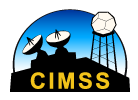On 01 June a pyroCb formed in Russia (56.5 N, 103.8E). HIMAWARI-8 detected the smoke plume and pyroCb cloud, as well as the fire hot spot. Starting at 5:00 UTC on 01 June, the animation below shows visible (.63 μm) on the left and shortwave IR (3.9 μm) on the right (click image to play animation). In the shortwave IR images the red pixels indicate very hot IR brightness temperatures exhibited by the fire source region.

HIMAWARI-8 0.63 µm visible channel (left) and 3.9 µm shortwave IR channel images (right) (click to play animation)
In addition, using HIMAWARI-8 10.4 μm IR channel the cloud-top IR brightness temperature could be found. The animation below, starting at 6:30 UTC on 01 June, shows the brightness temperature for the pyroCb is -46.4ºC around 07:10 UTC (lime green color enhancement).

HIMAWARI-8 10.4 µm IR channel images (click to play animation)
OMPS AI index images (courtesy of Colin Seftor) shows the transport of smoke on 2 June. The maximum AI index was found to be 3.7 at 54.8 N 115.4 E around 5:50 UTC. This is east of the original pyroCb indicating an eastward movement of the smoke.

OMPS Aerosol Index image on 02 June (click to enlarge)
The smoke was detected using CALIPSO lidar data. The images below show the products of lidar . The smoke can be seen between 52-58 N this is just east of the pyroCb and roughly were the OMPS AI index images are located. The first image below is the 532nm Total Attenuated Backscatter plot on 02 June from 05:08 UTC to 5:21 UTC. The smoke from this fires is indicated by a red and gray color. The second image is 1064 nm Total Attenuated Backscatter plot, the smoke on this plot is indicated by a yellow/red color. The third image is the Depolarization image the smoke is indicated by a blue color. The fourth image is the Attenuated Ratio plot between 1064 nm and 532 nm. The smoke is indicated by magenta pixels. The fifth image is the Vertical Feature Mask. This plot shows the different features that are in the atmosphere, the smoke is attributed as a cloud on this plot and is indicated by a light blue color. The last plot is shows the aerosol subtype, the smoke is indicated by black pixels in this image.

CALIPSO 532 nm Total Attenuated Backscatter on 02 June (click to enlarge)

CALIPSO 1064 nm Total Attenuated Backscatter on 02 June (click to enlarge)

CALIPSO Depolarization Ration on 02 June (click to enlarge)

CALIPSO Attenuated Color Ratio between 1064 nm and 532 nm on 02 June (click to enlarge image)

CALIPSO Vertical Feature Mask on 02 June (click to enlarge image)

CALIPSO Aerosol Subtype on 02 June (click to enlarge image)

































